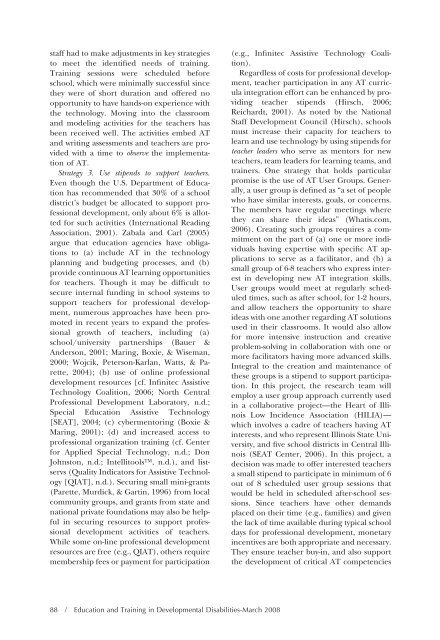Download the Journal (PDF) - Division on Autism and ...
Download the Journal (PDF) - Division on Autism and ...
Download the Journal (PDF) - Division on Autism and ...
Create successful ePaper yourself
Turn your PDF publications into a flip-book with our unique Google optimized e-Paper software.
staff had to make adjustments in key strategies<br />
to meet <str<strong>on</strong>g>the</str<strong>on</strong>g> identified needs of training.<br />
Training sessi<strong>on</strong>s were scheduled before<br />
school, which were minimally successful since<br />
<str<strong>on</strong>g>the</str<strong>on</strong>g>y were of short durati<strong>on</strong> <strong>and</strong> offered no<br />
opportunity to have h<strong>and</strong>s-<strong>on</strong> experience with<br />
<str<strong>on</strong>g>the</str<strong>on</strong>g> technology. Moving into <str<strong>on</strong>g>the</str<strong>on</strong>g> classroom<br />
<strong>and</strong> modeling activities for <str<strong>on</strong>g>the</str<strong>on</strong>g> teachers has<br />
been received well. The activities embed AT<br />
<strong>and</strong> writing assessments <strong>and</strong> teachers are provided<br />
with a time to observe <str<strong>on</strong>g>the</str<strong>on</strong>g> implementati<strong>on</strong><br />
of AT.<br />
Strategy 3. Use stipends to support teachers.<br />
Even though <str<strong>on</strong>g>the</str<strong>on</strong>g> U.S. Department of Educati<strong>on</strong><br />
has recommended that 30% of a school<br />
district’s budget be allocated to support professi<strong>on</strong>al<br />
development, <strong>on</strong>ly about 6% is allotted<br />
for such activities (Internati<strong>on</strong>al Reading<br />
Associati<strong>on</strong>, 2001). Zabala <strong>and</strong> Carl (2005)<br />
argue that educati<strong>on</strong> agencies have obligati<strong>on</strong>s<br />
to (a) include AT in <str<strong>on</strong>g>the</str<strong>on</strong>g> technology<br />
planning <strong>and</strong> budgeting processes, <strong>and</strong> (b)<br />
provide c<strong>on</strong>tinuous AT learning opportunities<br />
for teachers. Though it may be difficult to<br />
secure internal funding in school systems to<br />
support teachers for professi<strong>on</strong>al development,<br />
numerous approaches have been promoted<br />
in recent years to exp<strong>and</strong> <str<strong>on</strong>g>the</str<strong>on</strong>g> professi<strong>on</strong>al<br />
growth of teachers, including (a)<br />
school/university partnerships (Bauer &<br />
Anders<strong>on</strong>, 2001; Maring, Boxie, & Wiseman,<br />
2000; Wojcik, Peters<strong>on</strong>-Karlan, Watts, & Parette,<br />
2004); (b) use of <strong>on</strong>line professi<strong>on</strong>al<br />
development resources [cf. Infinitec Assistive<br />
Technology Coaliti<strong>on</strong>, 2006; North Central<br />
Professi<strong>on</strong>al Development Laboratory, n.d.;<br />
Special Educati<strong>on</strong> Assistive Technology<br />
[SEAT], 2004; (c) cybermentoring (Boxie &<br />
Maring, 2001); (d) <strong>and</strong> increased access to<br />
professi<strong>on</strong>al organizati<strong>on</strong> training (cf. Center<br />
for Applied Special Technology, n.d.; D<strong>on</strong><br />
Johnst<strong>on</strong>, n.d.; Intellitools, n.d.), <strong>and</strong> listservs<br />
(Quality Indicators for Assistive Technology<br />
[QIAT], n.d.). Securing small mini-grants<br />
(Parette, Murdick, & Gartin, 1996) from local<br />
community groups, <strong>and</strong> grants from state <strong>and</strong><br />
nati<strong>on</strong>al private foundati<strong>on</strong>s may also be helpful<br />
in securing resources to support professi<strong>on</strong>al<br />
development activities of teachers.<br />
While some <strong>on</strong>-line professi<strong>on</strong>al development<br />
resources are free (e.g., QIAT), o<str<strong>on</strong>g>the</str<strong>on</strong>g>rs require<br />
membership fees or payment for participati<strong>on</strong><br />
88 / Educati<strong>on</strong> <strong>and</strong> Training in Developmental Disabilities-March 2008<br />
(e.g., Infinitec Assistive Technology Coaliti<strong>on</strong>).<br />
Regardless of costs for professi<strong>on</strong>al development,<br />
teacher participati<strong>on</strong> in any AT curricula<br />
integrati<strong>on</strong> effort can be enhanced by providing<br />
teacher stipends (Hirsch, 2006;<br />
Reichardt, 2001). As noted by <str<strong>on</strong>g>the</str<strong>on</strong>g> Nati<strong>on</strong>al<br />
Staff Development Council (Hirsch), schools<br />
must increase <str<strong>on</strong>g>the</str<strong>on</strong>g>ir capacity for teachers to<br />
learn <strong>and</strong> use technology by using stipends for<br />
teacher leaders who serve as mentors for new<br />
teachers, team leaders for learning teams, <strong>and</strong><br />
trainers. One strategy that holds particular<br />
promise is <str<strong>on</strong>g>the</str<strong>on</strong>g> use of AT User Groups. Generally,<br />
a user group is defined as “a set of people<br />
who have similar interests, goals, or c<strong>on</strong>cerns.<br />
The members have regular meetings where<br />
<str<strong>on</strong>g>the</str<strong>on</strong>g>y can share <str<strong>on</strong>g>the</str<strong>on</strong>g>ir ideas” (Whatis.com,<br />
2006). Creating such groups requires a commitment<br />
<strong>on</strong> <str<strong>on</strong>g>the</str<strong>on</strong>g> part of (a) <strong>on</strong>e or more individuals<br />
having expertise with specific AT applicati<strong>on</strong>s<br />
to serve as a facilitator, <strong>and</strong> (b) a<br />
small group of 6-8 teachers who express interest<br />
in developing new AT integrati<strong>on</strong> skills.<br />
User groups would meet at regularly scheduled<br />
times, such as after school, for 1-2 hours,<br />
<strong>and</strong> allow teachers <str<strong>on</strong>g>the</str<strong>on</strong>g> opportunity to share<br />
ideas with <strong>on</strong>e ano<str<strong>on</strong>g>the</str<strong>on</strong>g>r regarding AT soluti<strong>on</strong>s<br />
used in <str<strong>on</strong>g>the</str<strong>on</strong>g>ir classrooms. It would also allow<br />
for more intensive instructi<strong>on</strong> <strong>and</strong> creative<br />
problem-solving in collaborati<strong>on</strong> with <strong>on</strong>e or<br />
more facilitators having more advanced skills.<br />
Integral to <str<strong>on</strong>g>the</str<strong>on</strong>g> creati<strong>on</strong> <strong>and</strong> maintenance of<br />
<str<strong>on</strong>g>the</str<strong>on</strong>g>se groups is a stipend to support participati<strong>on</strong>.<br />
In this project, <str<strong>on</strong>g>the</str<strong>on</strong>g> research team will<br />
employ a user group approach currently used<br />
in a collaborative project—<str<strong>on</strong>g>the</str<strong>on</strong>g> Heart of Illinois<br />
Low Incidence Associati<strong>on</strong> (HILIA)—<br />
which involves a cadre of teachers having AT<br />
interests, <strong>and</strong> who represent Illinois State University,<br />
<strong>and</strong> five school districts in Central Illinois<br />
(SEAT Center, 2006). In this project, a<br />
decisi<strong>on</strong> was made to offer interested teachers<br />
a small stipend to participate in minimum of 6<br />
out of 8 scheduled user group sessi<strong>on</strong>s that<br />
would be held in scheduled after-school sessi<strong>on</strong>s.<br />
Since teachers have o<str<strong>on</strong>g>the</str<strong>on</strong>g>r dem<strong>and</strong>s<br />
placed <strong>on</strong> <str<strong>on</strong>g>the</str<strong>on</strong>g>ir time (e.g., families) <strong>and</strong> given<br />
<str<strong>on</strong>g>the</str<strong>on</strong>g> lack of time available during typical school<br />
days for professi<strong>on</strong>al development, m<strong>on</strong>etary<br />
incentives are both appropriate <strong>and</strong> necessary.<br />
They ensure teacher buy-in, <strong>and</strong> also support<br />
<str<strong>on</strong>g>the</str<strong>on</strong>g> development of critical AT competencies
















